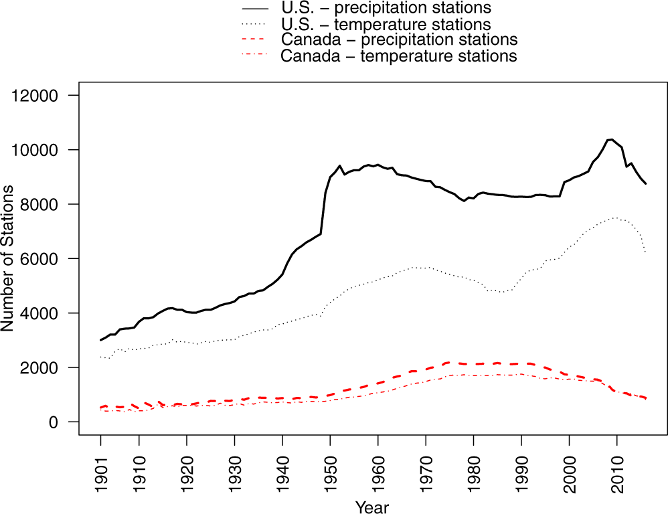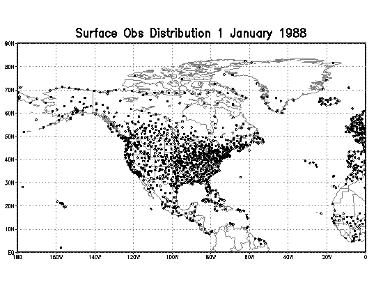Overview
This document provides an overview of precipitation gridded datasets created by the Canadian Forest Service, Natural Resources Canada. The dataset covers the period 1950 - 2017 at the daily, pentad and monthly time scale. 30-year averages were also created. The dataset was generated using ANUSPLIN with a 60 arc-second (approximately 2 km) and/or with a 300 arc-second (approximately 10 km) Digital Elevation Model (DEM; Lawrence et al., 2008), using station observations. Station data have been quality controlled, but are not homogenized. Daily data is available over Canada, while pentad, monthly, and 30-year time scales are available for continental North America and Canada.
Provider's contact information
This spatial dataset was developed by researchers from the Integrated Ecology and Economics Division at Canadian Forest Service at Natural Resources Canada (Dr. Dan McKenney, Dr. Heather MacDonald, John Pedlar, Kevin Lawrence, Pia Papadopol, Kaitlin de Boer from the CFS and Dr. Michael Hutchinson from Fenner School of Environment and Society, Australian National University). If you have questions about this dataset, please contact Dr. Dan McKenney (dan.mckenney@canada.ca)
Licensing
Freely available. Contact Dr. Dan McKenney, Canadian Forest Service, Natural Resources Canada, dan.mckenney@canada.ca
The following scientific publications should be cited if you use these data in publications:
Canada:
Hutchinson, M. F., D. W. McKenney, K. Lawrence, J. H. Pedlar, R. F. Hopkinson, E. Milewska, and P.Papadopol, 2009: Development and testing of Canada-wide interpolated spatial models of daily minimum–maximum temperature and precipitation for 1961–2003. J. Appl. Meteor. Climatol., 48, 725–741, https://doi.org/10.1175/2008JAMC1979.1.
Hopkinson, R.F., D.W. Mckenney, E.J. Milewska, M.F. Hutchinson, P. Papadopol, and L.A. Vincent, 2011: Impact of aligning climatological day on gridding daily maximum-minimum temperature and precipitation over Canada. Journal of Applied Meteorology and Climatology, 50(8), 1654-1665, doi:10.1175/2011JAMC2684.1.
North America:
MacDonald, H., D. W. McKenney, P. Papadopol, K. Lawrence, J. Pedlar, and M. F. Hutchinson, 2020: North American historical monthly spatial climate dataset, 1901–2016. Scientific Data, 7(1), 1-11, https://doi.org/10.1038/s41597-020-00737-2
Variable name and units:
Total precipitation (mm)
Spatial coverage and resolution:
| |Daily| Pentad| Monthly| 30 –year average| |--|--|--|--| |Region| Canada| Canada and North America| Canada and North America| Canada and North America| |Spatial resolution| ~ 2 km and ~ 10 km| ~ 2 km and ~ 10 km| ~ 2 km and ~ 10 km| ~ 2 km and ~ 10 km|
Temporal coverage and resolution:
Daily – 1950-2017
Pentad – 1950-2017
Monthly – 1950-2017
30-year Average – 1961/1990, 1971/2000, 1981/2010
The data will continue to be updated regularly.
Information about observations (number, homogeneity)
Over Canada, the datasets were generating using station observations from MSC at Environment and Climate Change Canada (ECCC). Station data have been quality controlled for the time of observation, but are not homogenized. The number of stations used for spatial modelling increased from 900 in 1950 to 2312 in 1985, and then declined to 1398 stations in 2017 (Figure 1). Stations are not evenly distributed in space. Many stations are located in southern Canada and fewer in northern Canada (Figure 2). For North America datasets, the ECCC stations were supplemented with GHCND hourly weather stations over the USA.

Figure 1. Number of Supporting Observing Stations by Year over Canada and USA (from MacDonald et al. (2020))

Figure 2. Location of precipitation stations used in North America ANUSPLIN datasets (from MacDonald et al., 2020). Note: Mexican stations were not covered by the digital elevation model.
Methodology
Quality-controlled, but unadjusted, station data from the National Climate Data Archive (NCDA) of Environment and Climate Change Canada data (Hutchinson et al., 2009) were interpolated onto the high-resolution grid using the trivariate thin plate splines interpolation method. As mentioned above, station density varies over time with changes in station availability, peaking in the 1970s with a general decrease towards the present day (Hutchinson et al., 2009). Thus, the number of stations active across Canada between 1950 and 2011 ranged from 2000 to 3000 for precipitation and 1500 to 3000 for air temperature (Hopkinson et al., 2011).
Daily precipitation data were corrected when flags indicated trace values and accumulated values over multiple days. Trace values were corrected depending on precipitation type and accumulated values were disaggregated using nearby stations if they were not covering periods longer than 4 days and stations within a 100 km radius could be used. For details see Hutchinson et al. (2009).
Spatial models were then generated using the trivariate thin plate splines interpolation method as implemented in Australian National University Spline (ANUSPLIN; Hutchinson & Xu, 2013) for daily precipitation. For pentad, monthly and 30-year averages, the time average is first computed for each station and the result is next used with ANUSPLIN and the corresponding Digital Elevation Model.
The models were updated with improvements in the bias for the data from 1900-2015 (MacDonald et al., 2021)
Information about the technical and scientific quality
The data were quality controlled (see Hutchinson et al., 2009) and use up-to-date spatial modelling methods as detailed in MacDonald et al., 2020. The references provide several publications that detail the scientific quality of this data set.
The dataset is accompanied by several scientific papers.
Limitations and strengths for application in North Canada
Hutchinson et al., (2009) provides a comparative assessment of the precipitation spatial model quality over Canada.
References to documents describing the methodology or/and the dataset
Lawrence, K.M., M.F. Hutchinson, and D.W. McKenney, 2008: Multi-scale digital elevation models for Canada. Natural Resources Canada, Great Lakes Forestry Centre Frontline Tech. Note 109, 4 pp., https://d1ied5g1xfgpx8.cloudfront.net/pdfs/31499.pdf.
Hopkinson, R.F., D.W. Mckenney, E.J. Milewska, M.F. Hutchinson, P. Papadopol, and L.A. Vincent, 2011: Impact of aligning climatological day on gridding daily maximum–minimum temperature and precipitation over Canada. J. Appl. Meteor. Climatol., 50, 1654–1665, https://doi.org/10.1175/2011JAMC2684.1.
Hutchinson, M.F., and T. Xu, 2013: ANUSPLIN version 4.4 user guide. Australian National University, Fenner School of Environment and Society Doc., 55 pp., https://fennerschool.anu.edu.au/files/anusplin44.pdf.
MacDonald, H., D. W. McKenney, P. Papadopol, K. Lawrence, J. Pedlar, and M.F. Hutchinson, 2020: North American historical monthly spatial climate dataset, 1901–2016. Scientific Data, 7(1), 411-411. https://doi.org/10.1038/s41597-020-00737-2
*MacDonald, H., D.W. McKenney, X.L. Wang, J. Pedlar, P. Papadopol, K. Lawrence, Y. Feng, and M.F. Hutchinson, 2021: Spatial models of adjusted precipitation for Canada at varying time scales. Journal of Applied Meteorology and Climatology, 60(3), 291 304. https://doi.org/10.1175/JAMC-D-20-0041.1
**McKenney, D. W., and et al., 2011: Customized spatial climate models for North America. Bull. Amer. Meteor. Soc., 92, 1611–1622, https://doi.org/10.1175/2011BAMS3132.1.
*Describes spatial models at the pentad time scale (adjusted precipitation only, ANUSPLIN-AdjPdly)
**Describes related spatial models available on an ongoing basis at different time scales
Link to download the data and format of data:
All data is available in asci format at Canadian Forest Service, NRCan (contact Dr. Dan McKenney, dan.mckenney@canada.ca if you are interested in the asci datasets)
Canada-wide daily dataset and North-America wide monthly dataset, both with 300 arc-second spatial resolution in netCDF format, are available at Canadian Center for Climate Services, ECCC (contact the Climate Services Support Desk, https://climate-change.canada.ca/support-desk/Inquiry, if you are interested in this netCDF subset of data)
Publications including dataset evaluation or comparison with other data in northern Canada
Hutchinson, M. F., D. W. McKenney, K. Lawrence, J. H. Pedlar, R. F. Hopkinson, E. Milewska, and P.Papadopol, 2009: Development and testing of Canada-wide interpolated spatial models of daily minimum–maximum temperature and precipitation for 1961–2003. J. Appl. Meteor. Climatol., 48, 725–741, https://doi.org/10.1175/2008JAMC1979.1